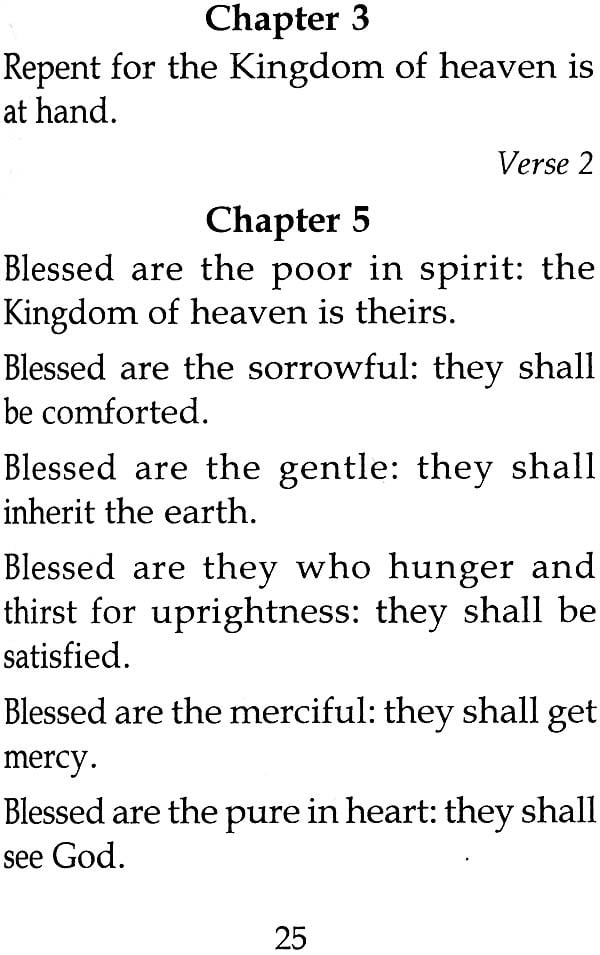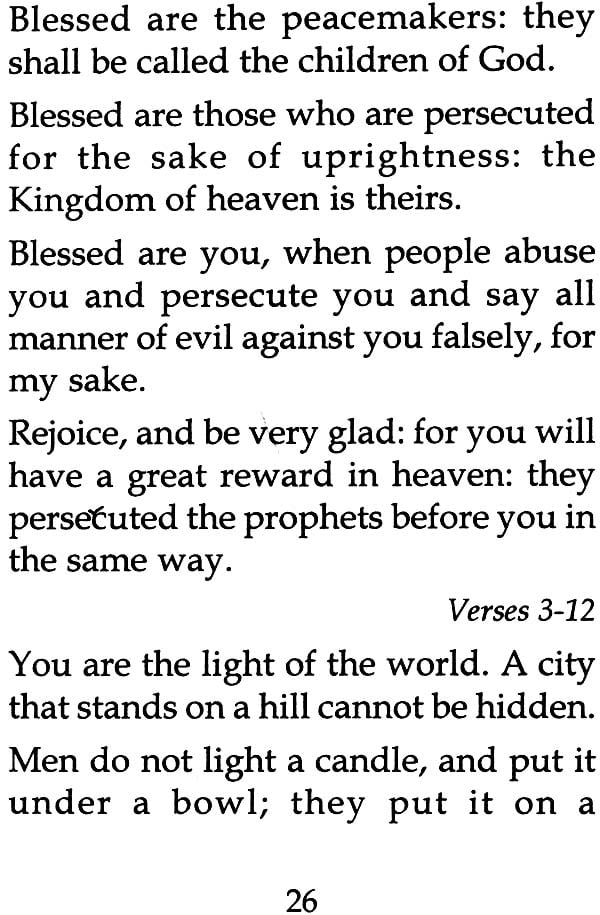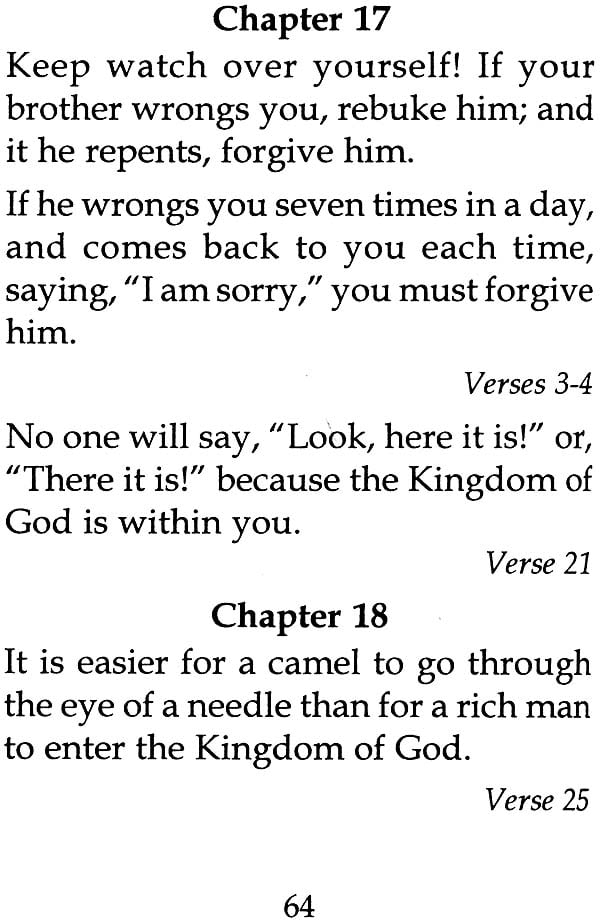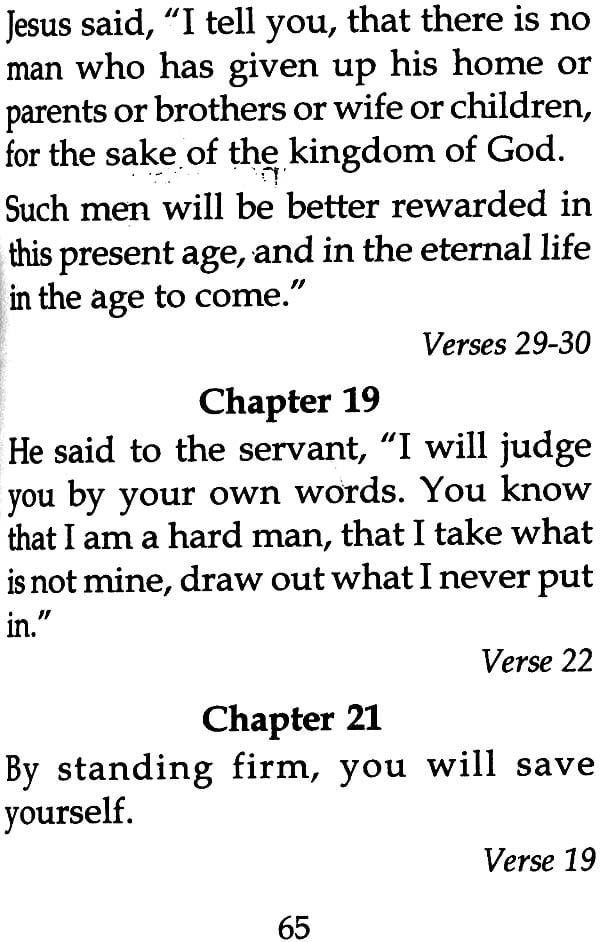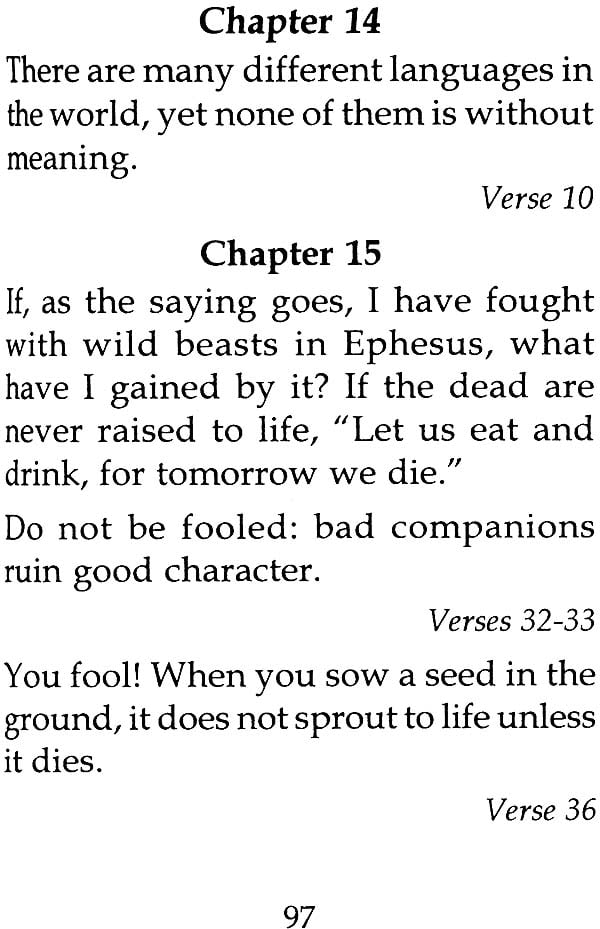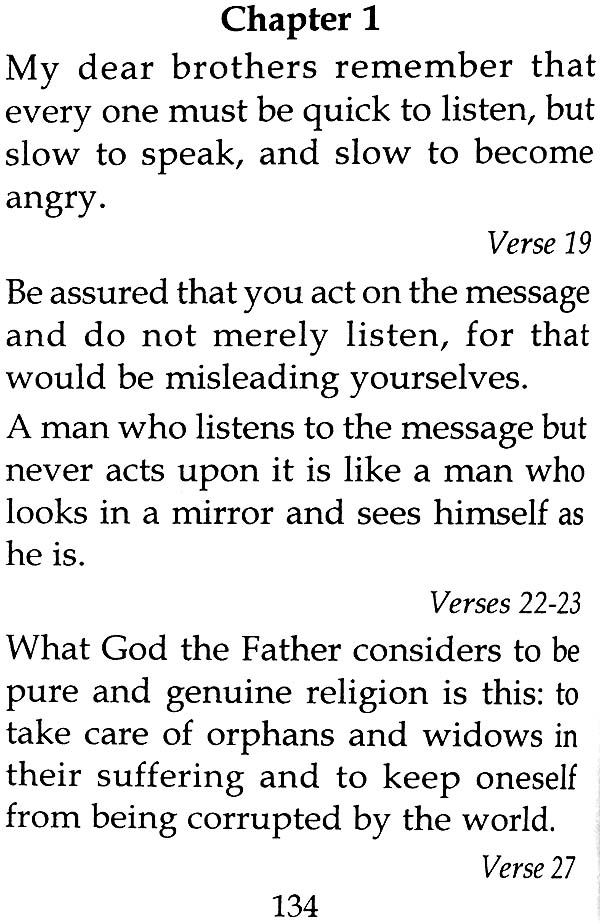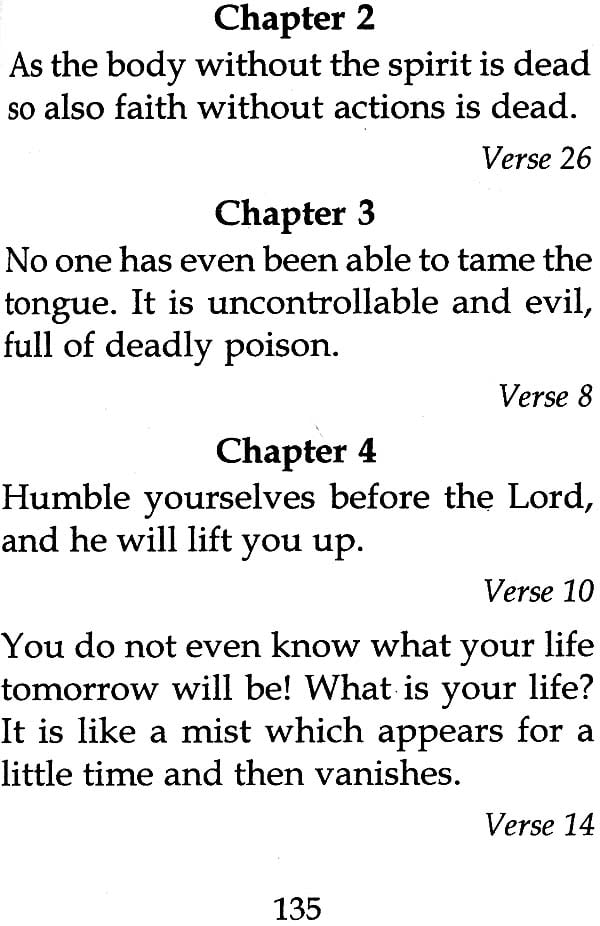
Selections from the Bible (The New Testament)
Book Specification
| Item Code: | NAJ112 |
| Author: | O. P. Ghai |
| Publisher: | New Dawn Press |
| Language: | English |
| Edition: | 2004 |
| ISBN: | 9788120725393 |
| Pages: | 160 |
| Cover: | Paperback |
| Other Details | 6.0 inch X 4.5 inch |
| Weight | 120 gm |
Book Description
Just one powerful thought at the beginning of the day can change your life. In this book O.P. Ghai has put together selections from The New Testament which help people lead a better life. The book attempts to present Biblical content in standard everyday English, so that today’s readers can appreciate the beauty of the original.
O.P. Ghai (1919 – 1992) was known for his communications skills. A publisher by profession and believer by faith in the fundamental unity underlying the great religions of the world, he sought religious co-existence through the written and the spoken worked by editing a treatise, Unity in Diversity, which became a widely translated book in India and abroad.
A graduate of Punjab University, Lahore, who started his career as a school teacher, he founded University Publishers, Sterling Publishers and the Institute of Book Publishing and rose to become a member of the Executive committee of the International Publishers Association, a rare honour.
Three major world religions, namely Judaism, Christianity and Islam, have several things in common: faith and practices centered around ethical norms and laws, the nature of God and His relations with people and world views resulting from these. Neither narrowly nor country based, these have found adherents all over the world, particularly Christianity and Islam. Yes, the zeal of the followers to spread their faith to others through gentle, and at times, not so gentle means, helped, no doubt in this. However, in the case of Buddhism, Jainism and especially Hinduism, the large underpinning for religion was provided by the culture of the people so that religion and culture became closely interlinked.
The series that Mr. O.P.Ghai has authored, focuses attention, on certain fundamental unity of various religions, in spite of differences. There are many points of confluence, if not congruence, between the world views of different religions, be it Hinduism or Christianity or any other religion. These find expression and articulation in the different scriptures. The role of suffering and its mystery, the presence of evil and the faith perspective, the idea of salvation or liberation, the means to attain such salvation, the role of sacraments and ethical life or sanskara, and ways and approaches to establish contact with the ultimate Reality, with God, through meditation, etc., (sadhana) are mentioned in the various scriptures.
The Bible (which literally means the book) is considered the Word of God by Christians. However, as Christian theologians would point out, there is a dual authorship of the various books of the Bible: on the one hand, the human author, conditioned by his times, his culture, education and background which are clearly reflected in his writing and which make it a truly human document and hence prone to error and, on the other hand, the divine author or the Word of God and His message, which He inspires the author to put down. Scriptural inspiration is a special miracle or grace given to the authors, who wrote the various books of the Bible. There are several factual errors in the Bible, the contribution of the human author. However, the inerrancy of the Bible refers to the truth revealed by God through the human author.
The Good News (which is what the word Gospel means) from God, brought to man, through Jesus, the Son of God, as written by the four authors and the letters by Paul and others, contain certain core teachings of Jesus. Jesus, born and brought up as a Jew, dared to challenge the status quo, the religious and ethical norms and traditions prevailing at His time, (often distortions of the original laws). He presented to the people a set of reorganized priorities, changed the emphasis from the outer to the inner, from reciting many prayers to praying in one's heart, pointed out the necessity to practice removal materialism from the spirit, namely detachment of the heart from the wordly possessions, and above all invited His followers to join together in building the human community man, in love and fellowship, pattern on the divine community of God, the Father, the Son and the Holy Spirit, the three persons of the Trinity, but one God. So radical and so different His life and teachings that while attracted many followers, it also provoked the wrath of the powers that be, who managed to have Him killed Yet, as the Gospel points out, He laid down His life, of His own will, as a sacrifice - for atonement of the sins of the world. Though as a human, He could die, jesus, the Son of God, rose from the dead. He wanted His followers to share in his mission of building a new earth, new people and a new community. He set before them this challenge of beginning an establishment of the Kingdom of God, a communitarian task and a mission, which would endure for eternity in all its fullness.
My interest in and love for sacred writings date back to the year 1930 when I, as a student, would read and recite the Japji, the great Sikh scripture, in the religious instruction class of my school. After passing the matriculation examination in 1934, I bought a copy of the Bhagavad Gita, the Hindu epic, and read it several times to be able to understand its divine message.
It was in 1938 that a friend of mine, knowing my religious leanings, presented me with a copy of the Bible which I used to read once in a while. The book created in me an urge to study the complete Holy Bible.
My next ten years were devoted to the teaching profession and family responsibilities. It was only in 1948, after the partition of the country, that I found the requisite leisure to indulge in extensive reading. This was during my stay in Bombay. I bought a number of books including The Sacred Writings of the World's Great Religions, The Bible of the World and a few other books, which explained in simple and concise language, the writings and essence of different religions. The books were written in simple English and they whetted my appetite for reading the principal texts of the great religions.
My first book, Unity in Diversity, with a foreword by Dr. Mulk Raj Anand, is a guide to the underlying principles of ethics and morals of the great religions of the world. The book created history in the publishing world and has already been brought out in thirteen Indian and foreign languages including German, French, Esperanto, and is now under production in twelve more foreign and Indian languages. It even has an edition in Braille which is being published by the Institute for the visually handicapped.
The book has been hailed as a positive contribution to the promotion of religious co-existence, national integration and international understanding. Encouraged by its success and the laudatory reviews it received from the press and comments from the public, I began working on a project of simplifying the scriptures.
Bhagavad Gita with a foreword by M.P. Pandit has been highly praised for its exposition, which has a simplicity and clarity of its own.
Japji with a foreword by Dr. Jaswant Singh Neki, has been widely appreciated for its clarification of complex expressions so that these become intelligible to the layman.
Selections from the Qur' an with a foreword by Prof. Rasheeduddin Khan, expounds on, the spirit and principles of Islam in understandable and simple English. It is meant specially for those who do not know Arabic, and their number runs into millions.
Selections from the Bible is the last volume of the project. The selections have been made from The New Testament, known as the authorized version. and rewritten in simple
The New Testament is the sacred book of the Christians. Though it is referred to as a book, it is actually a collection of twenty-seven books or writings. These writings were chosen from the mass of religious literature which was circulated among the early Christians. These writings first appeared in the Greek language. They have since been translated into almost all the known languages of the world. Innumerable versions are available in English. Early in the 17th century, King James of England ordered the English translation which is known as the Authorisd Version of the Bible.
A few papyri fragments date back to the 2nd century, while full manuscripts of the New Testament date as far back as the 4th or the 5th century, while still others belong to a period, sometime between the 5th and 6th centuries. The oldest complete manuscript of the New Testament, Codesc Sinaitieus, is in London.
The Christian Messiah, Jesus of Nazareth, was a Jew, deeply steeped in Jewish tradition and culture. He was brought up according to the customs of the Jewish community. He knew the Law. He assured his followers that his mission was to interpret the deepest meaning of the Law, namely God's self-revelation to the Jewish people. He thought of himself as one in a line of Prophets to give a true interpretation to what was to be put into words and deeds.
Soon, Jesus and his followers developed differences from the narrow nationalism of Judaism. Having understood the significance of Jesus Christ, his disciples carried the high ethical idealism of the greatest of the Prophets to all people, both Jew and non-Jew; his gospel was for all.
The first four books of the New Testament, known as the Gospel according to Matthew, Mark, Luke and John respectively, account and interpret the life of Jesus.
The fifth book is the story of the followers of Jesus after he died. It tells about the founding of the Christian Church by a small band of his followers.
The next twenty-one books of the Testament are letters written by the early Christians, most of them by St. Paul, the foremost Christian missionary. He wrote letters to the churches which he founded and several other churches. The authorship of some of the other letters is not known.
The last book in the New Testament, Revelation, is an example of the mass of literature which was circulated among the churches. It is an account of a vision experienced by John and is written in symbolic language. There are many interpretations of this book.
Growing out of the teachings of Jesus of Nazareth, Christianity developed into a religious movement in and beyond the Roman Empire. The Christians were at first persecuted by Jewish and Roman authorities but eventually Christianity became an official religion under Emperor Constantine. Gradually, it dominated Europe and the Middle East and spread throughout the world. Its missionary activities have carried it to all parts of the globe. The Bible has been translated into more than 1,000 languages. Christians today form the largest religious group in the world.
| Foreword | 12 | |
| Preface | 12 | |
| Acknowledgements | 17 | |
| Introduction | 19 | |
| 1 | The Gospel according to Saint Matthew | 24 |
| 2 | The Gospel according to Saint Mark | 47 |
| 3 | The Gospel according to Saint Luke | 51 |
| 4 | The Gospel according to Saint John | 67 |
| 5 | The Acts of the Apostles | 78 |
| 6 | The Epistle to the Romans | 82 |
| 7 | The First Epistle to the Corinthians | 92 |
| 8 | The Second Epistle to the Corinthians | 99 |
| 9 | The Epistle to the Galatians | 104 |
| 10 | The Epistle to the Ephesians | 107 |
| 11 | The Epistle to the Philippians | 111 |
| 12 | The Epistle to the Colossians | 114 |
| 13 | The First Epistle to the Thessalonians | 117 |
| 14 | The Second Epistle to the Thessalonians | 120 |
| 15 | The First Epistle to Timothy | 122 |
| 16 | The Second Epistle to Timothy | 124 |
| 17 | The Epistle to Titus | 126 |
| 18 | The Epistle to Philemon | 128 |
| 19 | The Epistle to the Hebrews | 130 |
| 20 | The Epistle of James | 133 |
| 21 | The First Epistle of Peter | 137 |
| 22 | The Second Epistle of Peter | 140 |
| 23 | The First Epistle of John | 142 |
| 24 | The Second Epistle of John | 145 |
| 25 | The Third Epistle of John | 147 |
| 26 | The Epistle of Jude | 149 |
| 27 | The Revelation of Christ to St. John | 151 |
| About the Author | 154 |
